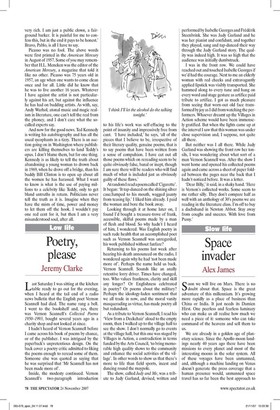Space invader
Alex James Soon we will live on Mars. There is no doubt about that. Space is the great adventure of this millennium. It's growing more rapidly as a place of business than China or India. It just needs its Damien Hirst. One peerless and fearless luminary who can make us all realise how much we need a piece of it: someone who can take command of the heavens and sell them to us.
We are already in a golden age of planetary science. Since the Apollo moon landings nearly 40 years ago there have been missions to every planet and most of the interesting moons in the solar system. All of these voyages have been unmanned, and, although a machine landing on Venus doesn't generate the press coverage that a human presence would, unmanned space travel has so far been the best approach to exploring the rest of the universe. There is very little to be gained scientifically from having a person on board a spacecraft at this stage, as instruments can be operated from mission control back here on the deck and the results are the same whether gathered by a man or a machine. The cost and risk of flying humans around in space would have been, well, astronomical.
There are plenty of people flying around in space as I write this, but they are all in Earth orbit. The Apollo astronauts are still the only people ever to have left the Earth's magnetic field. Looking back, that was quite a risky thing to do.
The main problems facing astronauts beyond near-Earth orbit are the vagaries and violence of space weather. The sun is an unimaginably aggressive place, a constant colossal nuclear explosion strapped to a sphere by immense gravity. About a hundred times a year the star erupts, firing huge clouds of its plasma into space. These events are called coronal mass ejections and I spent Friday afternoon looking at the latest photographs of them at the Rutherford Appleton Laboratory in Oxfordshire.
RAL is Europe's largest space research facility and I never know what to expect when I go. The buzz over there this week was a website: heavens-above.com. You key in your co-ordinates and it tells you all kinds of wonderful things, from when the space station will next be flying over your house to when you can next expect to experience an 'iridium flash'. The super-reflective iridium coating on satellites can catch the sun and mirror back at the dark side of the Earth, lighting up the back garden to brighter than full-moon levels for a few seconds. I couldn't wait for it to get dark, but it's been disappointingly cloudy since I logged on.
We had some cake and looked at the pictures of coronal mass ejections from the 'Soho' orbiting telescopes, and, after seeing a few of these cosmic maelstroms, I began to wonder how anything peaceful could exist in the universe. Cake seemed unlikely. Fortunately, the Earth's magnetic field deflects the charging atomic mini-missiles of the plasma away from us. From time to time, a particularly violent solar flare will knock out a whole power grid, as happened in Canada recently, but largely we are safe from sun storms.
Manned space flight is coming within our reach, but plasma is the biggest foreseeable problem for would-be astronauts. It smashes up DNA and causes cancer. Even the space station, well inside our magnetic field, has a 'panic room' where the spacemen can hide for the duration of a particularly violent solar event. The Apollo astronauts had no protection from coronal mass ejections. It was as if they'd nipped out to the shops without their coats, but managed to avoid a shower. Going to the moon and back is a few days' round trip, so although the risk was tangible, it was evidently worth taking. A round trip to Mars involves two years completely outside the magnetosphere, so we can't go there until we've worked out how to forecast and protect ourselves from space weather.We know how to launch and we know how to land. We know how to get there. Space weather is the main stumbling block — that and cash.
Dr Ruth Bamford showed me her antispace weather machine, a pleasing array of magnets with a whiff of agricultural antiglamour about it. It was working. She'd been firing beams of particles at her magnetically cushioned capsule. The particles were deflected around the capsule by the magnetic field. She was thrilled to bits. It was quite amazing, another small but significant step in the right direction. There are hundreds of rooms at the Rutherford Appleton Laboratory, and in each of them something rather incredible is happening. We may not hear much about it, but we are tumbling, leaderless into the space age.







































































 Previous page
Previous page